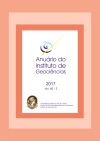Paleoenvironmental Evolution of the Restinga of Jurubatiba Lagoons, Rio de Janeiro State
DOI:
https://doi.org/10.11137/2017_3_266_280Keywords:
Foraminifera, lagoons, Holocene, sea-level oscillationAbstract
This work analysed assemblages of benthic foraminifera in core samples in lagoons from the Restinga de Jurubatiba Rio de Janeiro State, to observe paleoenvironmental changes and sedimentary deposition processes. Six cores were drilled (vibra-cores) until a depth of 1,56cm, in the Garças, Maria Menina, Robalo, Visgueiro, Catingosa and Pires lagoons. It was found that cores with sandy sediments presented lower abundance and richness of foraminifera species than fine sediment cores. Through the foraminiferal assemblages, four biofacies were characterized that relected episodes of distinct evolutionary conditions for each lagoon. For the sandy lagoons, it was recorded the biofacies Ammonia/ Elphidium representing moderate marine influence, and the biofacies Aglutinated/Trochammina inflata representing the lagoon confinement. At the muddy lagoons, occurred the biofacies Ammonia spp./Elphidium spp./Haynesina germanica which represents paleoenvironments with high marine influence and the biofacies A. tepida/ A. parkinsoniana with low marine influence that favor conditions to opportunistic species. Radiocarbon dating allowed to record, in the sedimentary deposition process of the lagoons, Holocene submergence phases related to the marine transgressions.Downloads
Download data is not yet available.
Downloads
Published
2019-07-30
How to Cite
Macedo, M. C. (2019) “Paleoenvironmental Evolution of the Restinga of Jurubatiba Lagoons, Rio de Janeiro State”, Anuário do Instituto de Geociências. Rio de Janeiro, BR, 40(3), pp. 266–280. doi: 10.11137/2017_3_266_280.
Issue
Section
Article
License
This journal is licensed under a Creative Commons — Attribution 4.0 International — CC BY 4.0, which permits use, distribution and reproduction in any medium, provided the original work is properly cited.















